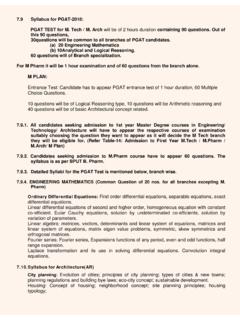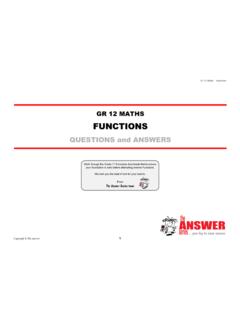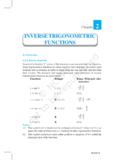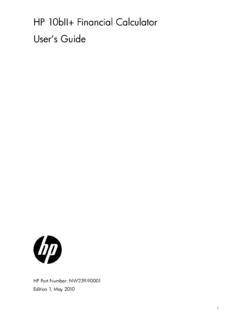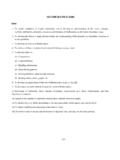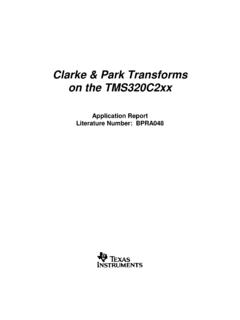Transcription of 7.5. SYLLABUS FOR MCA STREAM 7.5.1 …
1 SYLLABUS FOR MCA STREAM MATHEMATICS (60 Questions) Logic:Statement, Negation, Implication, Converse, Contraposititve, Conjuction, Disjunction, Truth Table. Different methods of proof, Principle of Mathematical induction. Algebra of sets: Set operation, Union, Intersection, Difference, Symmetric difference, Complement, Venn diagram, Cartesian product of sets, Relation and functions, Equivalence relation, Kinds of functions and their domain and range, Composite function, Inverse of a function. Number system: Real numbers (algebraic and order properties, rational and irrational numbers),Absolute value, Triangle inequality, AM GM, Inequalities(simple cases), Complex numbers, Algebra of complex numbers, Conjugate and square root of a complex number, Cube roots of unity, De Moivre s theorem with simple application.
2 Permutations and Combinations -simple applications, Binomial theorem for positive integral index, Identities involving binomial co-efficients. Determinants and matrices: Determinants of third order, Minors and cofactors, Properties of determinants, Matrices upto third order, Types of matrices, algebra of matrix, adjoint and inverse of matrix, Application of determinants and matrices to the solution of linear equations (in three unknowns). Trigonometry: Compound angles, Multiple and Submultiple angles, Solution of trigonometric equations, Properties of triangles, Inverse circular function, Sum and product of sine and cosine functions.
3 Co-ordinate geometry of two dimensions: Straight lines, Pairs of straight lines, Circles, Equations of tangents and normals to a circle, Equations of parabola, Ellipse and hyperbola in simple forms, their tangents and normals. Condition of tangency. Rectangular and Conjugate hyperbolas. Coordinate geometry of three dimensions: Distance and Division formulae, Direction cosines and direction ratios, Projection, Angle between two planes, Angle between a line and a plane. Distance of a point from a line and a plane. Equation of a sphere general equation, Equation of sphere when end points of diameter are given.
4 Vectors: Fundamentals, Dot and cross product of two vectors, Scalar triple product and vector triple product, Simple application of different products. Differential calculus: Concept of limit, Continuity of functions, Derivative of standard Algebraic and Transcendental functions, Derivative of composite functions, functions in parametric form, Implicit differentiation, Successive differentiation (simple cases), Leibnitz theorem, Partial differentiation, Application of Euler s theorem, Derivative as a rate measure, Increasing and decreasing functions, Maxima and Minima, Indeterminate forms, Geometrical application of derivatives such as finding tangents and normals to plane curves.
5 Integral calculus: Standard methods of integration (substitution, by parts, by partial fraction, etc), Integration of rational, irrational functions and trigonometric functions. Definite integrals and properties of definite integrals, Areas under plane curves. Differential equations: Definition, order, degree of a differential equation, Formation of a differential equation, Solution of a differential equations of the following types. (i) dy/dx = f(x) (ii) dy/dx = f(x) g(y) (iii) d2y/dx2 Probability and statistics: Average (mean, median and mode). Dispersion (standard deviation and variance), Definition of probability, Mutually exclusive events, Independent events, Compound events, Conditional probability, Addition theorem.
6 = f(x) Number system:Decimal, binary, octal, hexadecimal numbers and their conversion. COMPUTER AWARENESS (60 Questions) COMPUTER AWARENESS: Introduction to Computer: Brief history of Computers, Components of a Computer, Computer related general knowledge, Application of Computers, Classification of Computers, Windows. Computer Arithmetic: Number System with general base, Number base conversion, Elementary arithmetic operation. C Language: Keywords, Constants, Variables, Identifiers, operators, statements. Writing simple C program. Arithmetic and logical expression, simple if, nested if, if-else-ladder, conditional operators, switch case, for, while and do while loops.
7 Concept of functions in C. SYLLABUS FOR MBA (120 questions) Questions will be meant to measure a person s general Entrance test in the following aspects: No. of Questions Verbal reasoning 40 Analytical reasoning 40 General Knowledge 10 Comprehension 20 Computer and Business fundamentals 10 Sample Questions: A sample of questions is being provided for making the candidates aware of the style and difficulty level of the questions. The topics covered here in sample are not true indication of the SYLLABUS and the test may contain questions from all related areas under different sections.
8 The samples are given primarily to help the candidates understand the pattern of the test. Section A: Verbal Reasoning 1. Identify the odd word A. B. C. D. Sweep wipe Scrub Stain 2. The place where bricks are baked A. B. C. D. Foundry Mint Cemetery Kiln 3. My watch is 6 minutes fast and the train which should havearrived at my station at am was 5 minutes late. Whattime was it by my watch when the train arrived? A. am B. am C. am D. Don t Know Section B: Analytical Reasoning 1. Which of the following ratio is greatest? A . 7:15 B. 15:23 C. 17:25 D. 21:29 2. If 6 men and 8 boys can do a piece of work in 10 days while 26 men and 48 boys can do the same in 2 days, the time taken by 15 men and 20 boys in doing the same type of work will be: A.
9 4 days B. 5 days C. 6 days D. 7 days 3. When the integer n is divided by 6, the remainder is of the following is not a multiple of 6? A .n-3 B. n+3 C. 2n D. 3n Section C: General Knowledge 1. The term steeplechase is associated with A. Horse racing B. Boxing C. Polo D. Rowing 2. The first indigenously built missile boat is named as: A. INS Mani B. INS Shilpi C. INS Bibhuti D. INS Vikrant 3. Central Salt and Marine Chemicals Research Institute islocated at A. Ahmedabad B. Bhavanagar C. Gandhi Nagar D. Panaji Section D: Comprehension Speech is a great blessing but it can also be great curse, for which it helps us to make our intentions and desires known to our fellows, it can also, if we use it carelessly, make your attitude completely misunderstood.
10 A slip of the tongue, the use of an unusual word, or of an ambiguous word and so on, may create an enemy where we had hope to win a friend. Again different classes of people use different vocabularies, and the ordinary speech of an educated man may strike an uneducated listener as pompous. Unwittingly we may use a word which bears a different meaning to our listener from what it does to men of our own class. Thus speech is not a gift to use lightly without thought, but one which demands careful handling. Only a food will express himself a like to all kinds and conditions of men.
